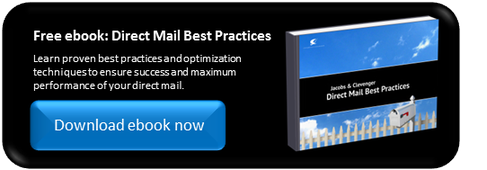
J&C Blog
Find all the latest marketing trends on the J&C Blog.

Find all the latest marketing trends on the J&C Blog.
 There’s a reason why certain consumer products have maintained the same design and function for decades: Despite all the advantages technology affords, some things are best enjoyed in their original form.
There’s a reason why certain consumer products have maintained the same design and function for decades: Despite all the advantages technology affords, some things are best enjoyed in their original form.
The same can be said of direct mail marketing. Sure, email and social media are new and exciting methods of communication, but mailboxes aren’t going anywhere. Many people still delight in receiving a tangible piece of mail because they’re intrigued by what it might contain: a friendly hello from an old pal, a really great deal from their favorite brand or even just the week’s news.
Direct mail is as relevant as ever. In fact, all the new advancements in communication have only served to buoy it. Marketing communications are made stronger when multiple channels are used to draw attention to a product or brand.
Following are reasons direct mail isn’t going anywhere.
Direct mail is personal. Relevancy can make or break a marketing campaign. The most important best practice is a simple but often forgotten one: personalization. Personalization helps marketers overcome hurdles to conversion. When marketers take the time to acknowledge the recipient by name in a direct mail letter, they demonstrate their commitment to customer value. But marketers can take personalization a step further. Direct mail letters can (and should) acknowledge any prior purchasing behavior by including relevant information a customer has expressed an interest in. For example, if a customer recently purchased a vehicle navigation system, send follow-up communications specific to that product or model, including any available upgrades and discounts.
 Direct mail is legit. It’s hard to pull the wool over a customer’s eyes with a direct mail communication. There’s less opportunity for smoke and mirrors. Of course, legitimacy can be easily undermined by typos, misinformation or incomplete information, and general sloppiness. To avoid the above, make sure you show your logo prominently on your direct mail letter, include your mailing address and web URL, and sign off the communication with a senior executive’s name, title and signature. These small details can remove a lot of doubt and encourage the recipient to read through your communication.
Direct mail is legit. It’s hard to pull the wool over a customer’s eyes with a direct mail communication. There’s less opportunity for smoke and mirrors. Of course, legitimacy can be easily undermined by typos, misinformation or incomplete information, and general sloppiness. To avoid the above, make sure you show your logo prominently on your direct mail letter, include your mailing address and web URL, and sign off the communication with a senior executive’s name, title and signature. These small details can remove a lot of doubt and encourage the recipient to read through your communication.
Direct mail appeals to all segments. That’s because it doesn’t require a fancy device or mobile optimization to be read. Direct mail is arguably the easiest marketing communication to read because it comes in a format that’s been around as long as paper. When developing a direct mail letter, marketers should focus their efforts on formatting the communication in a way that makes for easy reading. Content should be scannable with multiple subheads and bullet points. It should also include a right rail that summarizes key points of the letter, and a personalized response device (if applicable) that is easy to fill out. Direct mail can be easily customized to accommodate different segments. And anyone with a mailbox can access direct mail. No downloads or email passwords are required.
Direct mail doesn’t go straight to your spam folder … unless it’s riddled with typos and bad practices, in which case it’s probably headed straight to the recycling bin. One of the best things about direct mail is that most recipients will have to transfer the communication from their mailbox to … somewhere. They might tack it onto their fridge to revisit, it might go into a drawer with other important bills or it might be read through and addressed immediately. Our director of creative services calls this the “7-Second Successful Direct Mail Test.” Marketers can influence what recipients do with their direct mail letters and other marketing communications. It’s all a matter of implementing tried-and-true best practices and avoiding mistakes like these.
There’s a reason direct mail is still around. Direct mail marketers know what a successful direct mail campaign can accomplish for their brand. If you’re looking for an agency that specializes in direct mail communications, contact Jacobs & Clevenger to ensure you are leveraging the most effective direct mail best practices.
Topics: Direct Marketing
303 E Wacker Drive, Suite 2030
Chicago, IL 60601
Phone: 312-894-3000
Fax: 312-894-3005